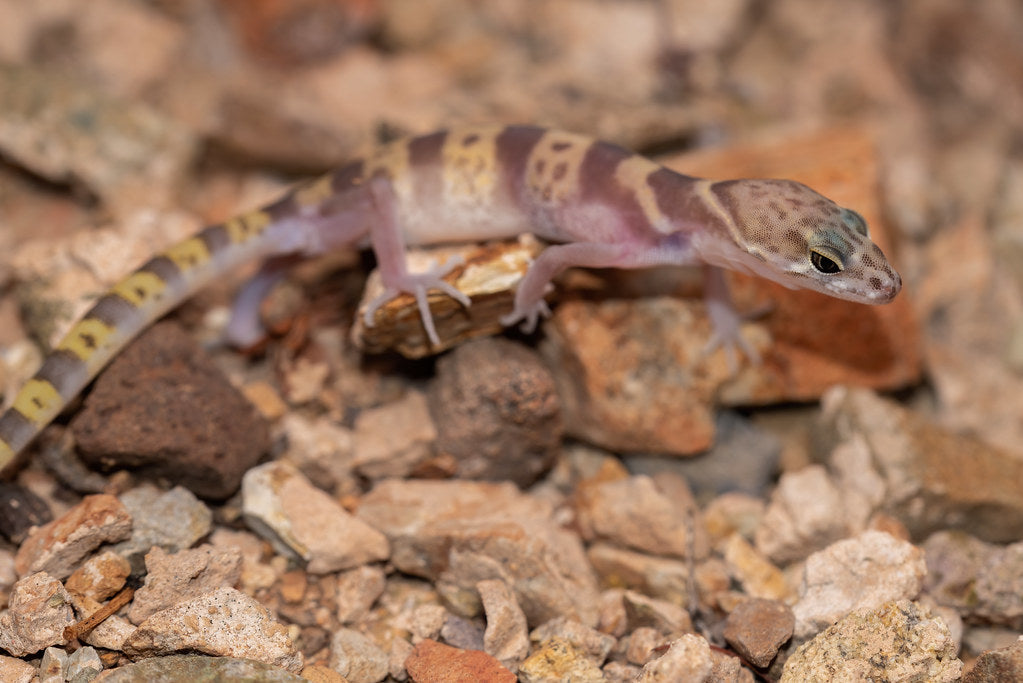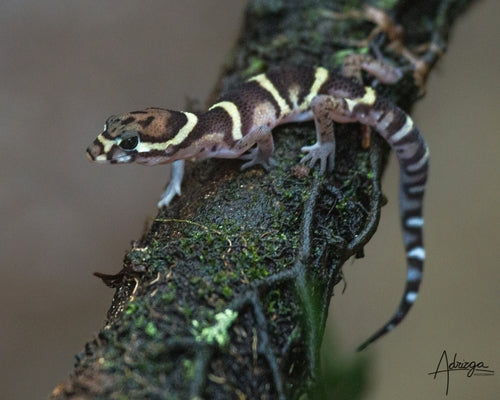Western banded geckos (Coleonyx variegatus) are small, nocturnal, terrestrial lizards native to dry coastal and desert areas of the southwestern United States and northern Mexico.
Western banded geckos are 4-6” long, with slender bodies and limbs, long toes, a triangular head, big eyes, vertical pupils, smooth skin, and a round, tapered tail. Pattern and coloring varies by locale, but they usually have a banded pattern of cream, yellow, tan, brown, and/or black, with adults being more spotted than juveniles. Unlike most geckos, banded geckos have eyelids and don’t have sticky toe pads.
Western banded geckos are less hardy than their leopard gecko cousins and less tolerant of handling, which makes them an intermediate-level pet reptile. With good care, they can live up to 15 years or more.
Note: Banded geckos may be native to the US, but that’s not a reason to take one from the wild if you want one as a pet. If you want a pet banded gecko, please do the responsible thing and support a breeder’s efforts. Never take reptiles from the wild!
How much space do western banded geckos need?
A single western banded gecko should be housed in no smaller than a 20 gallon (30” x 12” x 12” or 24” x 18” x 12”) terrarium. This is larger than the typical recommendation, but anything smaller will be unable to support all of the equipment that is needed to create a healthy environment for your gecko.
Cohabitation (keeping multiple western banded geckos in the same terrarium) is possible with this species. Unless you plan to breed, only house females together, and never put more than one male in the same enclosure, as they will fight! A 20 gallon terrarium will fit up to 3 geckos.
Do western banded geckos need UVB?
Western banded geckos are nocturnal, which means that they are most active from dusk to dawn. Technically banded geckos can survive without UVB lighting as long as they get supplemented with vitamin D3, but the fact remains that they can’t thrive without it. Aside from helping provide a day/night cycle, UVB is also good for your gecko’s overall wellbeing.
It’s best to provide low-strength UVB lighting as part of your gecko’s enclosure. The best UVB bulbs for banded geckos are:
- Zoo Med Compact Coil Reptisun 5.0, 26w
- Zoo Med T8 Reptisun 5.0, 18”
The UVB bulb should be roughly half the length of the enclosure and housed in a fixture with a reflector. If you are using a compact coil bulb, it must be mounted horizontally rather than vertically. Place the fixture on the basking side along with the heat lamp.
UVB is blocked by glass and plastic, so you can’t give your gecko UVB by placing its terrarium in front of an open window. This can also make your enclosure dangerously hot by creating a greenhouse effect! Also make sure that the fixture your UVB bulb is in does not have a clear plastic or glass bulb cover.
Lights should be on for 10 hours/day during winter, and 14 hours/day during summer to simulate seasonal changes in day length.
What basking temperatures do western banded geckos need?
Western banded geckos should have a warm hide temperature of 91°F, as measured by a digital probe thermometer with the probe placed inside the warm hide. There should also be a cooler area on the opposite side of the enclosure that stays between 72-77°F.
It’s best practice to provide heat for your gecko with two sources: a heat lamp and a heat mat. The heat lamp is for warming the air of the enclosure and providing short-wavelength infrared (heat) for the gecko to use as desired. The heat mat is for heating the warm hide to optimal temperature.
For the heat lamp, use a low-wattage white heat bulb placed on one side of the enclosure. If it's too warm, try a plug-in lamp dimmer. If it's too cool, you need a higher-wattage bulb. Do not use ceramic heat emitters (CHEs), red bulbs, or blue bulbs, as these are not as effective. Place the gecko’s warm hideout/cave below the heat lamp.
If your warm hide doesn’t get warm enough with the heat lamp alone, you will need a heat mat. The heat mat should be roughly the same size or a little larger than the hide itself, placed under the hide and covered with enough substrate to prevent direct contact. You must plug your heat mat into a thermostat to prevent it from overheating, which can be fatal! Place the thermostat probe inside the warm hide to accurately control temperature.
Heat sources should be turned off at night. Nighttime temperatures can drop as low as 65°F.
What humidity levels do western banded geckos need?
Western banded geckos need a low-humidity environment with access to a humid microclimate for best health. Average humidity should be 30-40%, as measured by a digital probe hygrometer with the probe in the middle of the terrarium.
However, you will also need to provide a humid hideout lined with moistened substrate or coconut fiber and placed on the cool end of the enclosure. The humid hideout should have 70% humidity or higher at all times.
What substrate is good for western banded geckos?
Substrate covers the floor of your gecko’s terrarium and helps make the enclosure more attractive, but it also helps maintain higher humidity levels and provides something for your gecko to dig in. Solid substrates like slate tile and terrarium mats are popular because of the common myth that geckos will get impacted if housed on a “loose”-type substrate (this only happens when the animal is already unhealthy due to poor husbandry). If you’re nervous, you can certainly use a solid substrate, but they have some significant disadvantages:
- Solid substrates need to be scrubbed frequently
- Solid substrates don’t cushion your dragon’s joints
- Solid substrates offer no enrichment value
It’s ideal to use a substrate that imitates the “substrate” that the reptile naturally lives on in the wild. For western banded geckos, that means it should be sand or sandy soil. It should have small particles, hold moisture well, and be loose enough to dig in.
We recommend the following substrates for western banded geckos:
Substrate should be at least 4” deep and completely replaced every 3-4 months. Remove poop and urates daily, along with contaminated substrate.
What décor can you use in a western banded gecko terrarium?
It’s terribly boring (and stressful!) for a gecko to be stuck in an enclosure with nothing in it except substrate and food/water bowls. It doesn’t matter how big the enclosure is if you don’t put things in it for your pet to use and interact with.
At bare minimum, you will need at least two “caves” for the gecko to hide in. However, it’s best to include other items, such as:
- small logs and branches
- climbing rocks
- ledges
- additional hides
- live or artificial plants
It’s also best practice to cover three sides of the enclosure to help the gecko feel more secure in its environment.
What do western banded geckos eat?
Banded geckos are insectivorous, which means that they need a diet of insects in order to get the nutrition that their bodies need. How often these geckos need to eat depends on age: Juveniles should be fed daily, and adults fed every other day.
One meal should be 2 appropriately-sized bugs per 1 inch of your gecko’s length, or however much they can eat in 15 minutes.
Feeder insects for banded geckos: dubia roaches, discoid roaches, crickets, black soldier fly larvae, hornworms, mealworms, mealworm beetles
Supplements
You will also need calcium and vitamin supplements to prevent your gecko from developing a deficiency. We recommend Repashy Calcium Plus LoD, lightly dusted on all of your gecko’s feeder insects.
Water
Of course, don’t forget a small water bowl for your gecko to drink from! Change the water daily and scrub the bowl with a reptile-safe disinfectant weekly, or whenever it becomes soiled.
Do western banded geckos like to be handled?
Banded geckos are not as handleable as leopard geckos, and generally prefer to be left alone, as handling can be stressful for them. Enjoy watching them, instead! If you want to interact with your gecko, try hand-feeding them with a pair of soft-tipped feeding tongs.
*This care sheet contains only very basic information. Although it’s a good introduction, please do further research with high-quality sources to obtain additional information on caring for this species.
"Tucson Banded Gecko, Coleonyx variegatus bogerti Klauber, 1945" by Misenus1 is licensed under CC BY-NC-SA 2.0



Leave a comment
This site is protected by hCaptcha and the hCaptcha Privacy Policy and Terms of Service apply.